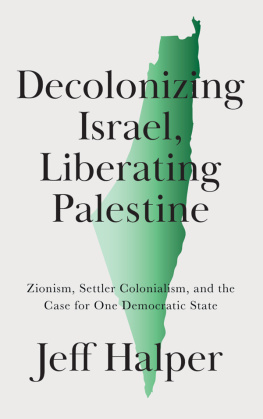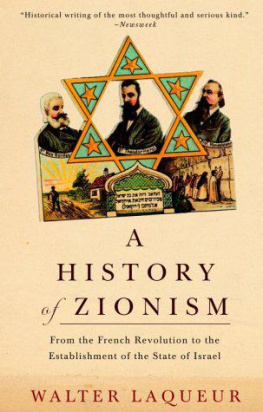Antony Loewenstein and Ahmed Moor - After Zionism: One State for Israel and Palestine
Here you can read online Antony Loewenstein and Ahmed Moor - After Zionism: One State for Israel and Palestine full text of the book (entire story) in english for free. Download pdf and epub, get meaning, cover and reviews about this ebook. year: 2012, publisher: Saqi Books, genre: Politics. Description of the work, (preface) as well as reviews are available. Best literature library LitArk.com created for fans of good reading and offers a wide selection of genres:
Romance novel
Science fiction
Adventure
Detective
Science
History
Home and family
Prose
Art
Politics
Computer
Non-fiction
Religion
Business
Children
Humor
Choose a favorite category and find really read worthwhile books. Enjoy immersion in the world of imagination, feel the emotions of the characters or learn something new for yourself, make an fascinating discovery.
- Book:After Zionism: One State for Israel and Palestine
- Author:
- Publisher:Saqi Books
- Genre:
- Year:2012
- Rating:4 / 5
- Favourites:Add to favourites
- Your mark:
- 80
- 1
- 2
- 3
- 4
- 5
After Zionism: One State for Israel and Palestine: summary, description and annotation
We offer to read an annotation, description, summary or preface (depends on what the author of the book "After Zionism: One State for Israel and Palestine" wrote himself). If you haven't found the necessary information about the book — write in the comments, we will try to find it.
After Zionism: One State for Israel and Palestine — read online for free the complete book (whole text) full work
Below is the text of the book, divided by pages. System saving the place of the last page read, allows you to conveniently read the book "After Zionism: One State for Israel and Palestine" online for free, without having to search again every time where you left off. Put a bookmark, and you can go to the page where you finished reading at any time.
Font size:
Interval:
Bookmark:
ONE STATE FOR ISRAEL AND PALESTINE
Edited by
Antony Loewenstein and Ahmed Moor
SAQI
ANTONY LOEWENSTEIN is an independent Australian journalist, activist and blogger. He is the author of two bestselling books, My Israel Question and The Blogging Revolution, co-editor of Left Turn and has written for the Guardian, the Nation, Huffington Post, Haaretz and other prominent publications. He is currently working on a book and documentary about disaster capitalism. He lives in Sydney, Australia.
AHMED MOOR is a Palestinian American journalist, blogger and activist and a Soros Fellow. He has written for the Washington Post, Los Angeles Times, Huffington Post, the Guardian and Al Jazeera English and is currently pursuing a masters degree in Public Policy at Harvard Universitys Kennedy School of Government.
Nothing will change until we are capable of imagining a radically different future. By bringing together many of the clearest and most ethical thinkers about the IsraeliPalestinian conflict, this book gives us the intellectual tools we need to do just that. Courageous and exciting. Naomi Klein, author of The Shock Doctrine
To our parents,
and the Palestinians and Israelis who deserve better
1. Presence, Memory and Denial
Ahmed Moor
2. The State of Denial:
The Nakba in the Israeli Zionist Landscape
Ilan Pappe
3. Reconfiguring Palestine: A Way Forward?
Sara Roy
4. The Power of Narrative:
Reimagining the Palestinian Struggle
Saree Makdisi
5. Protest and Privilege
Joseph Dana
6. Beyond Regional Peace to Global Reality
Jeff Halper
7. The Future of Palestine:
Righteous Jews vs. the New Afrikaners
John J. Mearsheimer
8. Israels Liberal Myths
Jonathan Cook
9. The Contract
Phil Weiss
10. Zionist Media Myths Unveiling
Antony Loewenstein
11. A Secular Democratic State in Historic Palestine:
Self-Determination through Ethical Decolonisation
Omar Barghouti
12. How Feasible is the One-State Solution?
Ghada Karmi
13. Zionism After Israel
Jeremiah Haber
The last fifteen years have seen the Middle East change in profound ways. The Al-Aqsa Intifada marked the end of the 1990s and the Oslo Process before it bled into the twenty-first century bringing with it widespread cultural and political change for the Palestinians and Israelis. In Israel, society shifted drastically to the Right as the Left disintegrated and the occupation became more deeply entrenched. The transformation found broad expression in a new consensus: that the Palestinians must be shut out and forgotten. The status quo became permanent.
The settlers in Israel have always had an outsized impact on their society. This partly has to do with the way in which majorities are cobbled together in the Israeli Knesset but it is also because of deliberate Israeli government policy. Virtually every Palestinian has witnessed the accelerated rate of land theft and growth of illegal settlements in the Gaza Strip and the West Bank on a first-hand basis. The conquest of Palestinian land typically occurs in the presence of an army patrol, acting on official orders, protecting state machinery; there is never anything rogue about what the settlers do.
Until 2005 Jewish fundamentalists who form the ideological core of the settler movement in the West Bank and Gaza were contented by the arrangement. It was only when former Israeli Prime Minister Ariel Sharon decided to extract roughly 8,000 of them from the Gaza Strip that the arrangement ceased to be comfortable. It did not matter to the settlers that Sharon was working to buttress their interests by placing the peace process in formaldehyde. All that was relevant was that the state had exhibited a willingness to defy the settler community.
Sharon succeeded. The peace process was frozen at the most senior levels of the American government. It was during that period that the second intifada faded from Israeli consciousness and a reasonable standard of security returned to Tel Aviv.
The past decade also saw the average Israeli become less liberal and more right-wing, a fact reflected by the election of Benjamin Netanyahu in 2009 and his re-election in 2013. It was a notable failure of the mainstream Left in Israel that the ongoing colonisation continued unopposed a factor that contributed to the Lefts ultimate dissipation.
The general apathy and right-wing malice directed at Palestinians worked to further empower the settlers who had learned the lessons of 2005 well. They worked successfully to place their representatives in high posts in the cabinet and infused the army with their numbers. Today, any move to evict large numbers of settlers from the West Bank will likely be met by mass insubordination. While the takeover of Israel by the settler minority was perhaps unforeseen by Ariel Sharon and David Ben-Gurion, the permanence of the settlement project was not.
Among the Palestinians, the second intifadas renewed focus on armed resistance and suicide bombings resulted in political isolation and the diminishment of Palestinian society. The violence provided Israel with an opportunity to distract from the fact that its colonisation of the West Bank was proceeding apace. The occupation was endorsed, funded, defended and built with Israeli and foreign money. Tragically, since the Oslo period, the international community has also funded the Palestinian Authority, a body designed to manage the occupation for Israel. It is an arrangement that suits the Zionist state well.
The tragedy deepened for the Palestinians when the man who embodied the struggle the international symbol of their aspirations was besieged in his compound by the Israelis for more than two years. Yasser Arafat was deprived of his dignity right up until the weeks preceding his death. His humiliation was something that many Palestinians felt acutely, both at a symbolic level and in their own lives.
Subsequent years brought political divisions between them. The fissure that existed between Fatah and Hamas under Arafat burst into armed conflict after his death. The violence worsened after Hamas won parliamentary elections in 2006. The following year saw the Islamic movement pre-empt a Fatah coup, and with that the Palestinian political body split along geographical lines. Fatah held the West Bank with Israeli and American help, while Hamas continued to govern the Gaza Strip, first with Iranian and Syrian help, then with aid from Qatar as the Palestinians distanced themselves from the civil war in Syria.
By 2007 it became clearer than ever that any talk of a two-state solution was empty. The combined effect of a ravenous colonisation project in the West Bank and deep internal Palestinian divisions both highlighted the reality. At the same time, Palestinian calls for equal rights were gaining in strength; and the Boycott, Divestment and Sanctions (BDS) movement appeared to provide an opening for a different kind of resistance to the occupation. BDS has now gone global at universities, businesses and in public debate.
Outside Israel and Palestine, global discussion about the conflict began to shift. Although the mainstream media still sympathised with the Zionist narrative, it wasnt so uncommon to hear the occasional call for the one-state solution and Palestinian Right of Return. Social media and citizen reporting from the West Bank and Gaza offered the world on-the-ground insights that made it impossible to deny the daily, harsh reality for Palestinians.
Font size:
Interval:
Bookmark:
Similar books «After Zionism: One State for Israel and Palestine»
Look at similar books to After Zionism: One State for Israel and Palestine. We have selected literature similar in name and meaning in the hope of providing readers with more options to find new, interesting, not yet read works.
Discussion, reviews of the book After Zionism: One State for Israel and Palestine and just readers' own opinions. Leave your comments, write what you think about the work, its meaning or the main characters. Specify what exactly you liked and what you didn't like, and why you think so.










